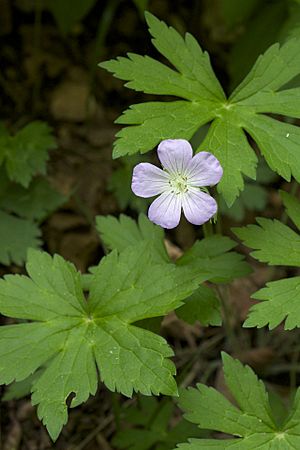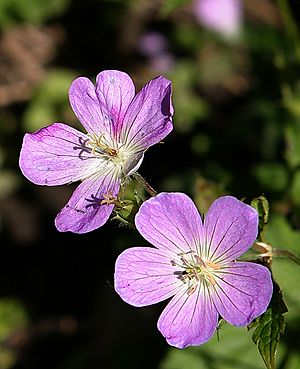Wild geranium facts for kids
Quick facts for kids Wild geranium |
|
|---|---|
 |
|
| Scientific classification | |
| Genus: |
Geranium
|
| Species: |
maculatum
|
Geranium maculatum, also called the wild geranium, spotted geranium, or wood geranium, is a plant that lives for many years. It grows naturally in the forests of eastern North America. You can find it from southern Manitoba and southwestern Quebec in Canada, south to Alabama and Georgia, and west to Oklahoma and South Dakota in the United States.
Contents
What People Call Wild Geranium
In Europe, this plant is often called spotted cranesbill or wild cranesbill. However, there is another plant called wood cranesbill (G. sylvaticum) which is different. Some other common names for Geranium maculatum are alum root, alum bloom, and old maid's nightcap.
Where Wild Geranium Grows
This plant likes to grow in forests that can be dry or a little wet. When you find it, there are usually many of them growing together.
What Wild Geranium Looks Like
Wild geranium is a plant that comes back every year. It can grow up to about 60 centimeters (2 feet) tall. It usually has straight stems that do not branch out. Its flowers appear in the spring and early summer.
Leaves of the Plant
The leaves of the wild geranium look a bit like a hand with fingers. They have five or seven deep sections. Each leaf is about 10 to 12.5 centimeters (4 to 5 inches) wide. The stem that holds the leaf, called a petiole, can be up to 30 centimeters (12 inches) long. These leaves grow from the plant's underground root system.
Wild Geranium Flowers
The flowers are about 2.5 to 4 centimeters (1 to 1.5 inches) across. They have five petals that are usually rose-purple, light purple, or violet-purple. Sometimes, they can even be white! Each flower also has ten stamens, which are the parts that make pollen.
In places like North America, these flowers usually bloom from April to June. They grow in small groups of two to five flowers at the top of the flower stems.
Fruit and Seeds
After the flowers, the plant makes a fruit capsule. This capsule looks like a long, thin beak, about 2 to 3 centimeters (1 inch) long. It reminds people of a crane's bill, which is why some call it a "cranesbill." When the fruit is ready, it pops open to release its seeds. Each capsule has five small sections, and each section holds one seed.
Underground Roots
The wild geranium has a long, thick underground stem called a rhizome. It is about 5 to 10 centimeters (2 to 4 inches) thick and has many branches. This rhizome has marks on it from where the stems grew in previous years. When it is dry, the inside of the rhizome looks a bit purplish.
Growing Wild Geranium
People often grow wild geranium in their gardens because it is a pretty plant. Many different types, called cultivars, have been created. One special type, named 'Elizabeth Ann', has even won an award for being a great garden plant.
Cool Uses for Wild Geranium
Besides being a garden plant, wild geranium has been used in traditional medicine. It is known as an astringent. This means it can help tissues tighten up and stop bleeding.
The Meskwaki Native American people used the roots of this plant. They would make a tea from the roots to help with toothaches and painful nerves. They also mashed the roots to treat hemorrhoids.
Gallery
-
Wild Geranium flowers in spring in Massachusetts



